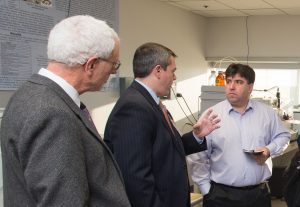
George Mason University’s Emanuel “Chip” Petricoin finds himself stepping out of the lab and into the boardroom as his discoveries form the basis for new firms.
Petricoin is co-director of the Center for Applied Proteomics and Molecular Medicine. His work has led to new companies, including personalized cancer therapy firm Perthera Inc. and Ceres Nanosciences—best known for its early diagnosis Lyme disease test. This summer Perthera received $8.7 million in venture capital funding.
Petricoin has some advice for researchers who want their discoveries to move into the commercial sector.
“It’s a relay race when the baton gets passed to businesses,” he said.
How does licensing your research to private companies fit into your research plan?
It’s great to learn there’s a commercial path for research findings. I’m learning a lot about the business side. I never took business classes in college—I was taking biochemistry so I couldn’t appreciate the hard work it takes to commercialize research. Commercializing research means it can improve lives. If your discoveries only end up in a journal, it’s not going to help the patient.
What have you learned about the business side of research?
I never understood what it takes to convince someone to invest their hard-earned money in your business. You have to convince them what you do is so important that you deserve their money.
It’s not necessarily what I want to spend all my time doing—I like being in the lab. But it’s important for scientists to understand where translational research fits into what we do. We want to be working in areas that are important to the public. It’s a huge part of the partnership between Inova and Mason.
Universities like Mason, more and more, are expected to be economic engines of a region and to produce research of consequence.
For researchers, discovering and publishing is the first step. Then, working with the university’s Office of Technology Transfer, to take the invention and package it, along with marketing, to the business community.
Even after all of that effort, the road is littered with the skeletal remains of companies that came and went. Not everything is going to work. You’re going to try and fail. But if you don’t try it, for sure it will not be going anywhere.
What are your top pieces of advice?
My recommendation is to know the investment community as much as possible. There’s a lot of networking that can be done. The scientists themselves can be tremendously useful because they’re the most knowledgeable about their work. Try to find a business partner and let them carry the ball. If you try to do it yourself, it’s tough.
Mason doesn’t have a long history of successful startups with an ecosystem of money and mentors. Mason doesn’t have that kind of stable yet, but Sean Mallon [Mason’s associate vice president for entrepreneurship and innovation] is working to change that.
I’m hoping I can be an effective mentor. Everyone has to have their own path, but you need mentors. Advice is invaluable.
What would you tell other scientist-entrepreneurs?
Don’t go it alone. For every one company that succeeds with one scientist doing it all, there are a hundred that didn’t work. Business is tough. People do not suffer fools. You have to be thick-skinned on top of it all and you can’t take it personally.
Perthera wouldn’t have happened if former Mason President Alan Merten didn’t get [venture capitalist] Dendy Young and me together. I was able to learn with Dendy and he has a tremendous acumen for business. He can talk circles around me from a business standpoint, but I contributed by bringing the science. I think we’re a good team.
With Ceres Nanosciences, we have Ross Dunlap leading it and taking care of the business side while we provide the scientific support.
What drives you?
Most scientists don’t go into science to make money. You’re doing it for intellectual curiosity. It’s all about science and discovering something new. But what makes scientists’ hearts beat a little faster is if what they discovered could help someone. When that happens, it’s the best feeling anyone can imagine.
